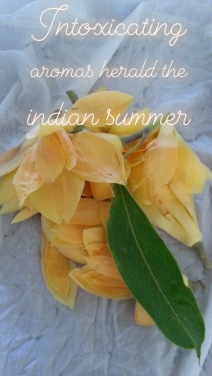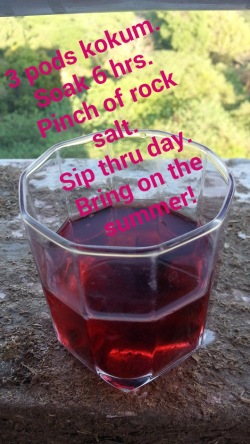As the temperature soars into the 40’s, thinking and action slows down, sometimes into reverie.
 ‘Patrimoine’. It’s the French word for heritage. Ok, let’s not argue right now…about why the word isn’t ‘Matrimoine’ and the etymological roots of it. That, for later. I’m dreaming of other types of roots.
‘Patrimoine’. It’s the French word for heritage. Ok, let’s not argue right now…about why the word isn’t ‘Matrimoine’ and the etymological roots of it. That, for later. I’m dreaming of other types of roots.
Childhood memories of Indian summers. Dense teak forests of central Maharashtra and the pre-monsoon Arabian Sea at the Konkan coast. The Sal tree groves of Kanha in Madhya Pradesh, the scorching tribal belt of Chattisgarh and a yellow-orange mountain while climbing the ghats to Pachmarhi.
Resplendent sights of laburnum and gulmohur in full bloom, jungle alarm calls of monkeys and deer.
Exquisite smells of jasmine, magnolia, vetivert, and delectable tastes of indigenous fruits.
The HOT summer in the Western Ghats is absolutely divine even today. If you are one with it, of course. If you don’t fight it. If you can dig your teeth into a juicy, pulpy, watery local fruit. Sit under a shady tree and wait for a small gust of wind. Or just wait. For nothing at all. Stillness.
Instead, the onslaught of branded, plastic bottled, canned or packaged drinks is in your face. You lose sight of what works locally, and has for centuries. Your roots.
To bring the cooling drink traditions back in focus, a few Sahyadri summer heritage recipes below. Of course they’re well known, indeed I’m no chef and this is not a recipe site! Just a nudge, a move, a method to explore your own roots. From the intellectual to the easily actionable.
Khus water:

The first and most important – water infused with khus. It is simply divine. Botanical name for khus – Chrysopogon Zizanioides. It’s a medicinal plant also known as Vetivert. Called वाळा in Marathi. ‘Khus’ in Marathi, Urdu, Hindi and other Indian languages.
Drop a ball of khus in a large earthen pot (matka) of drinking water to flavour the water overnight. Not to be confused with khus syrup available in market, which is for sherbet. This one is pure root form, floating in a pot of drinking water.
No colour.
Panha (my mother’s recipe):
 Botanical name for mango – Mangifera Indica. ‘Panha’ is the Marathi name for a drink made from raw mangoes, saffron, cardamom and mint.
Botanical name for mango – Mangifera Indica. ‘Panha’ is the Marathi name for a drink made from raw mangoes, saffron, cardamom and mint.
Pressure cook ‘Kairies’ (raw, green mangoes) till soft. Peel and extract pulp. Mix equal measures of kairi pulp+sugar+water (more sugar by taste). Add a pinch of salt, crushed cardamom and saffron. Blend. Store this concentrate in fridge.
To consume, put a few tablespoons in a glass, add water, stir and serve.
My mother tells me that in the old days they’d throw the ‘kairies’ straight into the wood/charcoal ‘chulha’ to roast before pulping.
The saffron turns this pale green drink into a pale orange.
Kokum drink (without sugar):

Botanical name for kokum – Garcinia Indica. Called Kokum in Marathi and Konkani. Rich in “hydroxy citric acid (HCA)….inhibits the conversion of carbohydrates into fats;…Garcinol;…antioxidant, anti-inflammatory, anti-bacteria and anti-carcinogenic agent…neuro-protective…and pitta balancing qualities.” (source: Kokum – The Malabar Tamarind by Vandana Shiva & Maya Goburdhun)
If you can’t source kokum rind locally, you can get it on Amazon. Syrups contain sugar and I prefer not to buy more plastic bottles, so I make my kokum drink from rind. It’s easy. You can even make it in a college hostel! Abandon those fizzies and bottled thing-ies!
Soak 2-3 pieces of kokum rind in a glass of water for a few hours with a pinch of rock salt (or any salt, or none). Stir and drink, chilled or cool.
It’s a deep maroon drink, with hints of purple.
Sol kadhi:
Coconut milk (botanical name, cocos nucifera) gives the basic kokum drink a delicious twist!
Soak 2-3 pieces of kokum in 3/4 glass of water with half a pod or less of crushed garlic and a bit of crushed green chilly to taste. Add rock salt to taste. Let sit. After a few hours, top up the glass with coconut milk. Shake well in jar or blender. Let sit again for half hour in fridge. Garnish with coriander. Drink cold.
A gorgeously pink drink.
Cold coffee A2 milk :

Cold coffee is not a traditional drink but A2 milk is.
Organic milk from Gir, Deoni or any other indigenous breed of Indian cow was no specialty when my mother was young. Now it’s much harder to source. I find desi cow’s, organic, raw milk (unpasteurised, non-homogenised) lighter and more flavourful. Boil it before drinking, of course!
Mix instant coffee. Sugar to taste. Whip it up. Drink cold.
Light brown.
 Taak, Buttermilk, Chaas…
Taak, Buttermilk, Chaas…
A little dahi (yogurt), water, ginger, cumin powder…
Add whatever your mother or grandmother told you to….!
Nimbupani, naariyal pani, of course!
Note: The Western Ghats or Sahyadri mountain range is known for its rich bio-diversity and runs along the western coast of India. It is a UNESCO World Heritage Site.
May the Sahyadris, and the abundance they give us, endure!
- (A recent article on the Sahyadris from Suprabha Seshadri – Once Upon A Biome
- The best kokum I’ve ever tasted comes from Sujata Goel’s beautiful organic farm Mojo Plantation.)
Postscript:
I received a message from Pascal Monteil (http://pascalmonteil.net) that significantly adds to the intent of my piece. Here it is in French below with English translation:
“Juste une petite remarque. En français Patrimoine n’est pas exactement tradition même si c’est proche. Ce sont les richesses culturelles ou materielles qui sont transmises en héritage. Ou bien personnellement dans une famille. Maisons. Vignes… ou bien à un peuple. Chateaux oeuvres mais aussi Culture, cuisine, vins, choses de l’esprit”
“Just a small note. In French, the word ‘patrimoine’ is not exactly ‘tradition’, even if it is close (in meaning). It is the cultural or material wealth that is transmitted through heritage. Or indeed, (transmitted) in a family. Houses. Vines….or to a people. The castles, yes, but also culture, cuisine, wines and things of the spirit.”